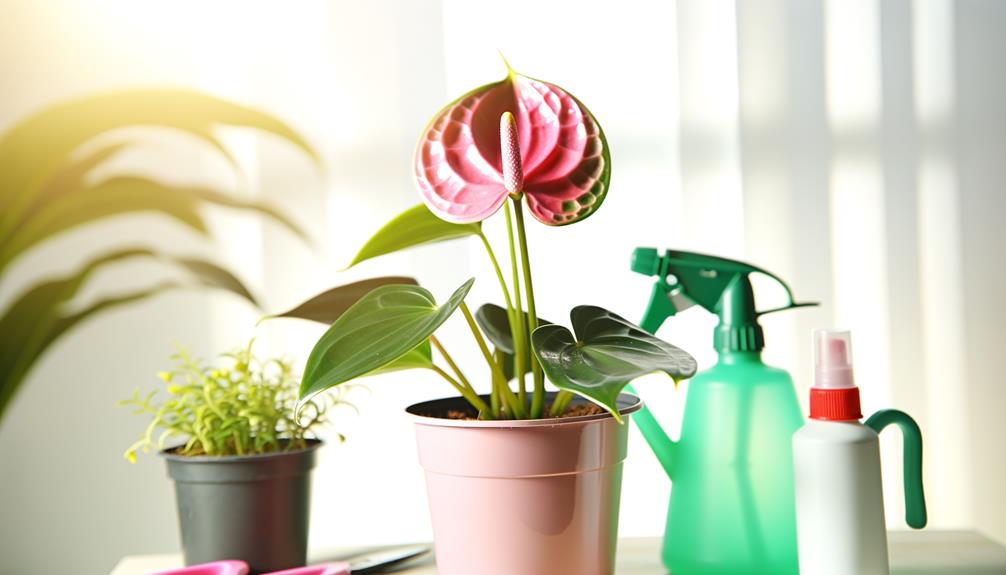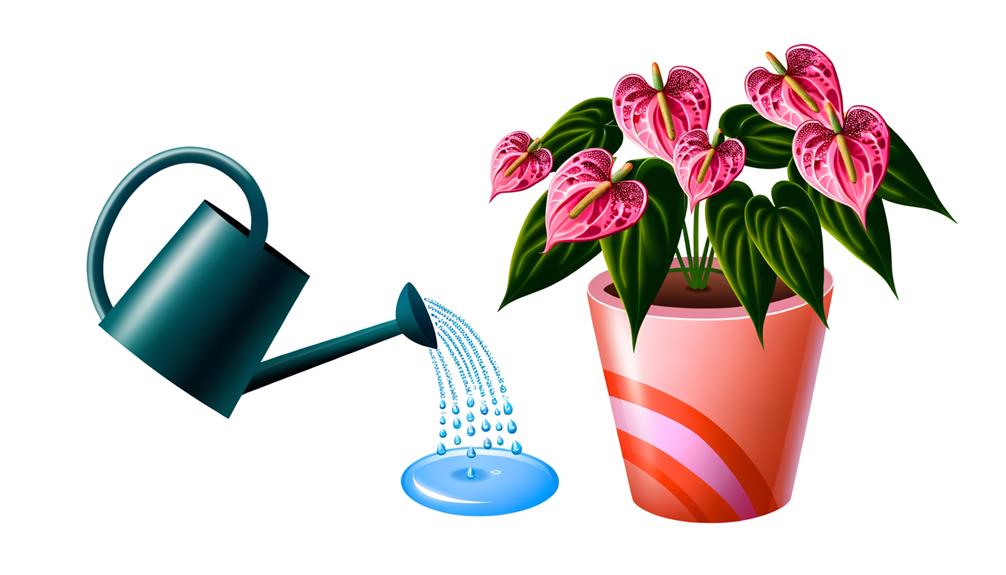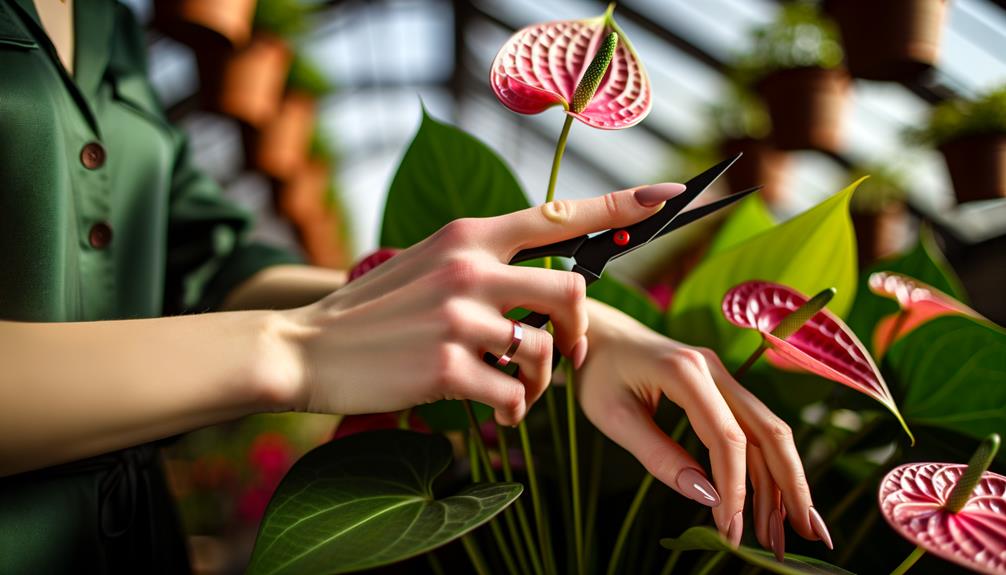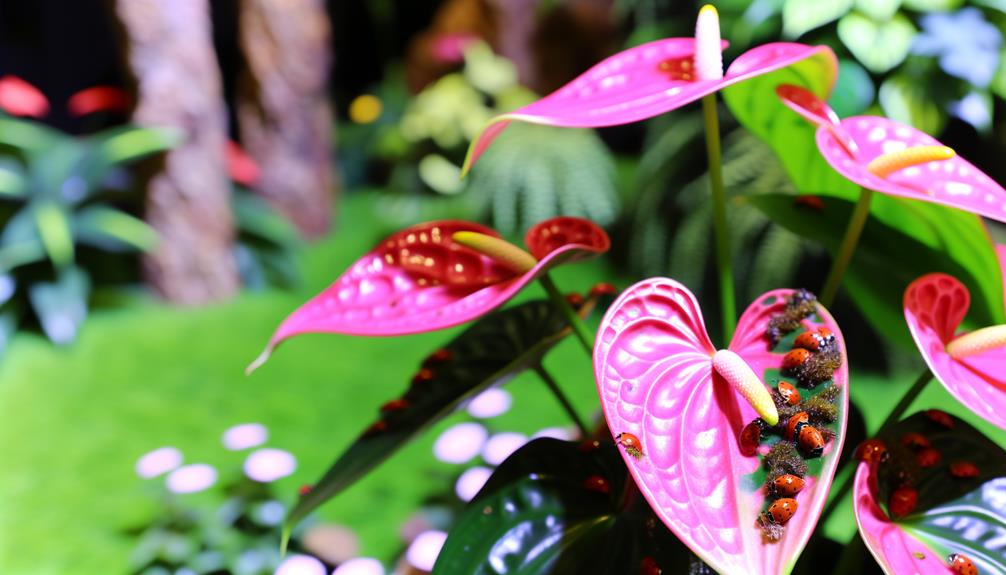Essential Care Tips for Your Anthurium Pink Lemonade
Guarantee your Anthurium Pink Lemonade thrives by placing it in bright, indirect light and maintaining temperatures between 65°F and 80°F. Allow the top inch of soil to dry before watering, and keep humidity levels around 70-80%.
Use a well-draining soil mix with a pH of 5.5 to 6.5, and repot every 2-3 years. Prune annually and inspect for pests like aphids and mealybugs.
Avoid root rot by adjusting watering and ensuring pots have adequate drainage. These guidelines are essential for sustaining the vibrant health of your plant; there’s more to discover about its care.

Key Takeaways
- Place in bright, indirect light and avoid direct sunlight to prevent leaf scorching.
- Water when the top inch of soil is dry and maintain 70-80% relative humidity.
- Use well-draining soil with a pH between 5.5 and 6.5.
- Prune dead or yellowing leaves and inspect regularly for pests like Aphids and Spider Mites.
- Repot every 2-3 years with fresh soil mix and use pots with drainage holes to prevent root rot.
Optimal Light Conditions

For optimal growth, position your Anthurium Pink Lemonade in bright, indirect light to replicate its natural rainforest understory habitat.
This plant flourishes under filtered sunlight, which mimics the dappled light found beneath a dense canopy. Direct sunlight can cause leaf scorching, while insufficient light results in leggy growth and diminished vibrancy.
Place your Anthurium near an east or north-facing window, making sure it receives ample diffused light throughout the day. If natural light is inadequate, consider using a grow light with a spectrum close to natural sunlight.
Regularly rotate the plant to guarantee even exposure and balanced growth. By optimizing light conditions, you’ll promote robust foliage and vibrant blooms, enhancing the overall health and aesthetic appeal of your Anthurium Pink Lemonade.
Ideal Temperature Range
Maintaining an ideal temperature range is paramount for Anthurium Pink Lemonade, as this tropical plant thrives in consistent temperatures between 65°F and 80°F (18°C to 27°C). This range mimics its native habitat, ensuring optimal physiological processes.
Fluctuations below 60°F (15°C) can induce stress, potentially leading to stunted growth and leaf damage. Conversely, temperatures exceeding 85°F (29°C) may cause dehydration and chlorosis.
| Temperature (°F) | Effect on Plant |
|---|---|
| Below 60°F | Stress, stunted growth |
| 65°F – 70°F | Optimal growth |
| 71°F – 75°F | Ideal blooming |
| 76°F – 80°F | Vigorous foliage |
| Above 85°F | Dehydration, chlorosis |
Watering Frequency

When watering your Anthurium Pink Lemonade, make sure the soil maintains ideal moisture levels by allowing the top inch to dry out between waterings.
Adjust the watering frequency seasonally, increasing during active growth periods and reducing in dormancy.
Be vigilant for signs of overwatering, such as yellowing leaves and root rot, to preserve plant health.
Optimal Soil Moisture Levels
Achieving the best soil moisture level for Anthurium Pink Lemonade involves watering the plant when the top inch of soil feels dry to the touch. Maintaining ideal hydration requires a balance to prevent both under-watering and over-watering.
Here’s a method to help you:
- Check Soil Moisture: Insert your finger about one inch into the soil. If it feels arid, it’s time to water.
- Water Thoroughly: Pour water until it drains out of the bottom of the pot, ensuring uniform distribution and preventing root rot.
- Drainage: Confirm the pot has adequate drainage holes to avoid water stagnation, which can lead to root diseases.
Seasonal Watering Adjustments
As the seasons change, you’ll need to adjust your watering routine for Anthurium Pink Lemonade to accommodate varying temperatures and humidity levels.
During the warmer months, increased evaporation and higher metabolic rates necessitate more frequent watering. Conversely, in cooler months, reduced evaporation and slower growth mean less frequent watering is required.
| Season | Watering Frequency |
|---|---|
| Spring/Summer | Every 5-7 days |
| Fall | Every 7-10 days |
| Winter | Every 10-14 days |
Monitor the soil’s moisture content and make sure it’s consistently moist but not waterlogged. Use your finger to test the soil; if it’s dry to the touch about an inch down, it’s time to water. This careful adjustment will guarantee your Anthurium Pink Lemonade thrives year-round.
Signs of Overwatering
Overwatering your Anthurium Pink Lemonade can lead to root rot, which manifests through yellowing leaves and a wilted appearance despite the soil being damp.
Root rot occurs when excessive moisture creates an anaerobic environment, facilitating pathogenic fungi.
To diagnose overwatering:
- Yellowing Leaves: Chlorosis indicates disrupted nutrient uptake due to waterlogged roots.
- Wilting Despite Moist Soil: The plant appears thirsty; however, the roots are suffocating from lack of oxygen.
- Mushy Roots: Upon inspection, roots should be firm and white; mushy, brown roots signal decay.
To prevent excessive watering, make sure the pot has adequate drainage and allow the soil to dry between waterings. Monitor humidity and adjust watering frequency according to seasonal variations and environmental conditions.
Humidity Requirements
Optimizing humidity levels is crucial for the healthy growth of your Anthurium Pink Lemonade. These tropical plants thrive in environments with 70-80% relative humidity. Mimic their native rainforest habitat by placing a humidity tray nearby or using a room humidifier.
Regularly misting the leaves with distilled water can also help maintain ideal moisture. Monitor the humidity with a hygrometer to ensure it stays within the desired range.
Be mindful of seasonal changes; during winter, indoor heating can drastically lower humidity levels. Position your Anthurium away from direct drafts and heaters, as sudden shifts in humidity can stress the plant.
Consistent humidity will promote robust foliage and vibrant blooms, optimizing your Anthurium Pink Lemonade to flourish beautifully.
Soil Type and Mix

For Anthurium Pink Lemonade, you should prioritize well-draining soil with a composition that includes orchid bark, perlite, and peat moss to guarantee proper aeration.
Aim for a prime pH level between 5.5 and 6.5, as this range facilitates nutrient uptake and promotes healthy growth.
Regularly monitor and adjust the soil mix to sustain these conditions.
Well-Draining Soil Composition
A well-draining soil mix for Anthurium Pink Lemonade should combine elements like orchid bark, perlite, and peat moss to guarantee root aeration and moisture retention.
This composition mimics the plant’s natural rainforest habitat, promoting robust growth and vibrant blooms.
Specifically, you should aim for a mix with the following proportions:
- Orchid Bark (40%): Provides large particles that enhance aeration, preventing root decay.
- Perlite (30%): Lightweight and porous, it ensures excellent drainage while preserving some moisture.
- Peat Moss (30%): Retains moisture effectively and maintains a slightly acidic environment, crucial for nutrient uptake.
Optimal Ph Levels
Achieving the best pH level for your Anthurium Pink Lemonade’s soil mix is essential for excellent nutrient absorption, and it should range between 5.5 to 6.5 to match its natural rainforest conditions.
Utilize a soil mix that includes peat moss, perlite, and pine bark to guarantee optimal acidity. Regularly test the pH with a reliable meter and adjust accordingly using sulfur to lower pH or lime to raise it. Below is a quick reference table for soil amendments:
| pH Level | Amendment Needed | Typical Dosage |
|---|---|---|
| Below 5.5 | Lime | 1 tbsp/gallon |
| 5.5 – 6.5 | None | N/A |
| Above 6.5 | Sulfur | 1 tsp/gallon |
Maintaining these levels will ensure your Anthurium thrives in a home environment.
Fertilization Schedule
To guarantee your Anthurium Pink Lemonade thrives, apply a balanced, water-soluble fertilizer every 6-8 weeks during the growing season.
This maximizes the plant receives essential macro and micronutrients for robust growth and vibrant blooms.
Follow these steps for best results:
- Dilution Ratio: Mix the fertilizer at half the recommended strength to avoid nutrient burn, ensuring the roots can absorb nutrients efficiently.
- Application Timing: Apply the fertilizer in the morning when the plant’s metabolic processes are most active, facilitating nutrient uptake.
- Soil Saturation: Confirm the soil is moist before fertilizing to prevent root damage and promote even nutrient distribution.
Pruning Techniques

While pruning your Anthurium Pink Lemonade, focus on removing any dead or yellowing leaves to encourage healthier growth and more prolific blooming.
Utilize sterilized pruning shears to make clean cuts, minimizing the risk of infections. Target the oldest leaves at the base and any stems that appear to be crowding the plant, as this enhances air circulation and light penetration.
Here’s a quick reference table to guide your pruning:
| Action | Description |
|---|---|
| Remove Dead Leaves | Cut at the base, just above the stem joint. |
| Trim Yellowing Leaves | Remove partially discolored leaves. |
| Thin Crowded Stems | Cut excess stems to improve airflow. |
| Use Sterilized Shears | Prevents disease transmission. |
| Prune Annually | Promote sustained health and vigor. |
Repotting Guidelines
After ensuring your Anthurium Pink Lemonade is pruned for peak health, it’s equally important to repot the plant every 2-3 years to refresh the soil and accommodate its growing root system.
When repotting, you should:
- Select the Right Pot: Choose a pot that’s one size larger and has adequate drainage to prevent waterlogging.
- Prepare the Soil Mix: Use a well-draining, organic mix composed of orchid bark, peat, and perlite to mimic the plant’s natural habitat.
- Transplant Carefully: Gently remove the plant from its current pot, shake off excess soil, and place it in the new pot, filling gaps with the fresh mix.
Pest Management

Effective pest management for your Anthurium Pink Lemonade involves regularly inspecting the plant for signs of common pests like aphids, mealybugs, and spider mites, and employing targeted treatments to mitigate infestations.
Look for discolored leaves, sticky residue, and webbing—these are telltale signs. Use insecticidal soap or neem oil to treat affected areas. For severe infestations, consider introducing beneficial insects like ladybugs or predatory mites.
Here’s a quick reference table for pest identification and treatment:
| Pest Type | Treatment Method |
|---|---|
| Aphids | Insecticidal soap |
| Mealybugs | Neem oil |
| Spider Mites | Water spray, neem oil |
| Severe Cases | Beneficial insects (e.g., ladybugs) |
Regular vigilance and timely intervention are key to maintaining your Anthurium’s health.
Common Issues
A common issue you might encounter with your Anthurium Pink Lemonade is root rot, often caused by overwatering or poor drainage.
This fungal disease compromises the plant’s ability to absorb nutrients and water, leading to wilting and yellowing leaves.
To prevent root rot, follow these steps:
- Watering Schedule: Make sure the soil is slightly dry before the next watering. Overwatering suffocates roots and creates a breeding ground for fungi.
- Soil Composition: Use a well-draining mix, incorporating perlite or orchid bark to improve aeration.
- Pot Selection: Choose containers with ample drainage holes to avoid water accumulation.
Conclusion
To sum up, nurturing your Anthurium ‘Pink Lemonade’ is like tending to a delicate dance of light, temperature, and moisture. Keep its environment just right, and it will reward you with vibrant blooms.
Remember, consistency is key; erratic care can lead to a cascade of issues. With scientific precision and a gardener’s intuition, you’ll master the art of keeping this botanical gem in peak condition, ensuring it thrives and dazzles for years to come.






